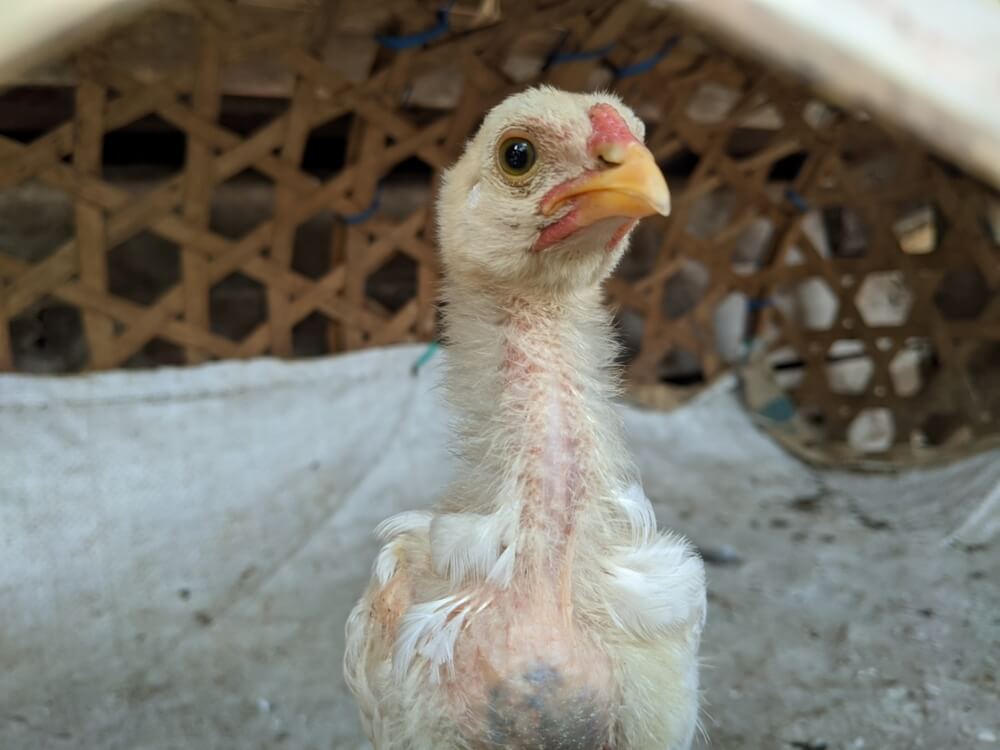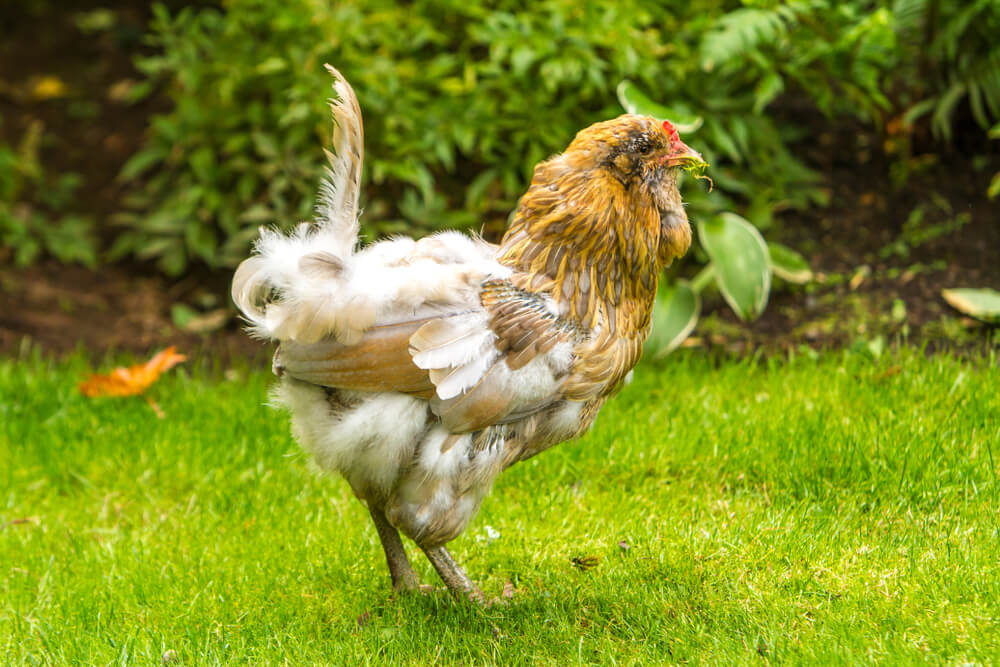So you come out one day, and your coop looks like your kids had a pillow fight. What on earth is going on? If your flock is healthy and there aren’t any signs of parasites or other issues, you may have molting chickens. If your normally fluffy birds suddenly sport sparse feathers and seem less vibrant these are natural signs of chicken molting. The good news is that it’s an entirely natural process.
A safe and comfortable chicken coop is crucial during the molting process, as it provides a sense of security and reduces stress for your hens.
As backyard chicken owners ourselves, we’ll unravel the mysteries of chicken molting in this comprehensive guide and help you understand this vital part of their lifecycle.
Introduction to Molting

Chickens usually molt from the tops of their heads and necks down their backs and then all the way to their tail. During this time, chickens may appear less lively, and their energy levels might dip. This is because growing new feathers requires a substantial amount of energy and nutrients. High-protein chicken feed is essential during molting to support feather regrowth and overall health.
The purpose of this blog post is to equip backyard chicken owners with the knowledge needed to support their birds during molting and subsequent feather production. Expect to learn about the stages of molting, signs to watch for, nutritional needs, and how to manage your chickens’ health and egg production during this period. Let’s start by exploring the different phases of the molting cycle.
What is Chicken Molting?

One of the most noticeable changes during molting is that chickens stop laying eggs. This is because the energy and nutrients that would normally go into egg production are redirected towards feather production. While it might be disappointing to see a temporary halt in egg laying, it’s important to remember that this is a normal part of a chicken’s life cycle. Molting ensures that your chickens maintain healthy feathers, which are crucial for their overall well-being and ability to withstand the elements.
Why Do Chickens Molt?
Chickens molt for several important reasons. One of the primary reasons is to replace old, worn-out feathers with new ones. Feathers are made up of around 85% protein and play a crucial role in keeping chickens warm, dry, and protected from the elements. As feathers wear out, they need to be replaced to maintain the chicken’s overall health and comfort.
Molting also allows chickens to adjust to changes in their environment, such as the onset of winter or fluctuations in temperature and humidity. This adaptability is vital for their survival and well-being. Additionally, molting helps chickens get rid of external parasites, such as mites and lice, which can cause discomfort and health problems. By shedding their old feathers, chickens can effectively eliminate these pests and reduce the risk of infestations.
Understanding why chickens molt can help backyard flock owners better support their birds through this natural process, ensuring they remain healthy and comfortable year-round.
The Molting Cycle

The first stage of molting is known as the “catastrophic molt.” During this phase, chickens lose a significant number of feathers quickly, often resulting in a patchy appearance. This stage can be quite alarming for chicken owners, but it’s perfectly normal. Following this initial feather loss, chickens enter the regrowth phase, where new feathers, known as pin feathers, emerge. Pin feathers are sensitive and contain a rich blood supply, so handling chickens during this phase is not advisable as it could lead to injury or bleeding.
The duration of the molting process varies among individual chickens but typically lasts between 8 to 12 weeks. Some chickens may molt faster, while others take longer. Factors such as age, breed, and environmental conditions play a role in determining the length of the molting cycle.
Baby chicks will molt twice while growing into adults chicks. The first molt starts at about six to eight days old and lasts until four weeks or so when the chicks down is replaced by its first feathers. The second juvenile molt is between 7 to 12 weeks old when the first feathers are replaced by the second set of feathers. This is when a rooster will get its ornamental feathers.
Signs of Losing Feathers
Recognizing the signs of molting is essential for ensuring the well-being of your chickens. The most obvious indicator is the noticeable loss of feathers, particularly around the neck, back, and tail. These areas may appear bare or scruffy, leaving your once-fluffy birds looking rather like characters from fraggle rock. Time for a quick you tube video if you haven't heard of that one.
The significance of chickens' feathers during molting is crucial, as the high protein content in feathers means that chickens are focused on regrowing feathers rather than laying eggs, leading to temporary reductions in egg output. Don’t be surprised if their demeanor changes as well; molting can be a stressful time for chickens.
In addition to feather loss, you may notice changes in your chickens’ behavior. They might become less active and spend more time resting or preening. Some chickens may also become more irritable or withdrawn during molting. The feather shaft, which contains a rich blood supply during feather emergence, is particularly sensitive during this time, so providing a stress-free environment is important. Their reduced activity level is due to the energy-intensive nature of growing new feathers, and this change in behavior is completely normal.
Another sign of molting is a decrease in appetite. Chickens may eat less during this time, as their bodies direct more nutrients towards feather regrowth. Understanding these signs helps you differentiate molting from potential health issues, ensuring that your chickens receive the appropriate care.
Nutritional Needs for New Feathers During Molting

Consider incorporating high-protein foods into your chickens’ diet, such as mealworms, sunflower seeds, or specially formulated molting feeds. These supplements help meet the increased protein requirements during molting. Additionally, providing access to a balanced layer feed ensures your chickens receive essential vitamins and minerals necessary for optimal feather growth.
Calcium is another vital nutrient during molting. While calcium primarily supports eggshell production, it’s also important for overall bone health. Chickens may temporarily stop laying eggs during molting, but maintaining calcium levels remains crucial. Offering crushed oyster shells or supplementing with calcium-rich foods can help your chickens through this period. Once hens begin producing eggs again after molting, transitioning back to a suitable layer feed that meets their energy and nutritional requirements is essential.
Health and Care During Molting

Regular health checks are important during molting. Keep an eye out for signs of illness or parasites, as chickens can be more vulnerable to health issues during this time. Check for lice or mites, which may take advantage of weakened immune systems. Promptly addressing any health concerns ensures your chickens remain healthy throughout the molting process.
Additionally, maintaining proper hygiene in the coop is essential. Clean bedding, fresh water, and a balanced diet contribute to your chickens' overall health. Providing dust baths can help reduce external parasites and promote healthy feather growth. By prioritizing your chickens' well-being, you can ensure a smooth molting experience for your flock.
Impact on Egg Production
One noticeable impact of molting is a temporary decrease in egg production. Chickens divert their energy and resources towards feather regrowth rather than egg-laying during this time. It's important to manage your expectations and understand that reduced egg production is a natural part of the molting process.
Egg production typically resumes once molting is complete and chickens have fully regrown their feathers. The duration of decreased egg production varies among individual chickens, with some resuming laying sooner than others. Patience is key during this period, as forcing hens to lay eggs prematurely can negatively impact their health.
While egg production may decline, it's important to continue providing your chickens with a balanced diet. Adequate nutrition supports both feather regrowth and eventual egg production. By focusing on their nutritional needs and overall well-being, you can help your chickens return to normal egg production once molting is complete.
Frequently Asked Questions
How long does molting last?
Molting typically lasts between 8 to 12 weeks, but individual chickens may have shorter or longer molting periods.
Can molting affect my chickens' egg-laying schedule?
Yes, molting often leads to a temporary decrease in egg production as chickens redirect energy towards feather regrowth.
Should I stop feeding my chickens layer feed during molting?
While it's important to provide additional protein during molting, maintaining a balanced layer feed ensures your chickens receive essential nutrients.
Get Your Molt On
Hopefully this helped you become more familiar with molting and when it's going to happen. By recognizing the stages, signs, and nutritional needs of molting, you can support your chickens through this natural process.
Remember to prioritize your chickens' health by providing a stress-free environment, regular health checks, and a balanced diet. With patience and proper care, your chickens will complete their molting cycle and return to normal egg production.
If you have additional questions or concerns about chicken molting feel free to reach out . By staying informed, you can continue to enjoy the rewarding experience of raising backyard chickens and supporting their health and happiness.





